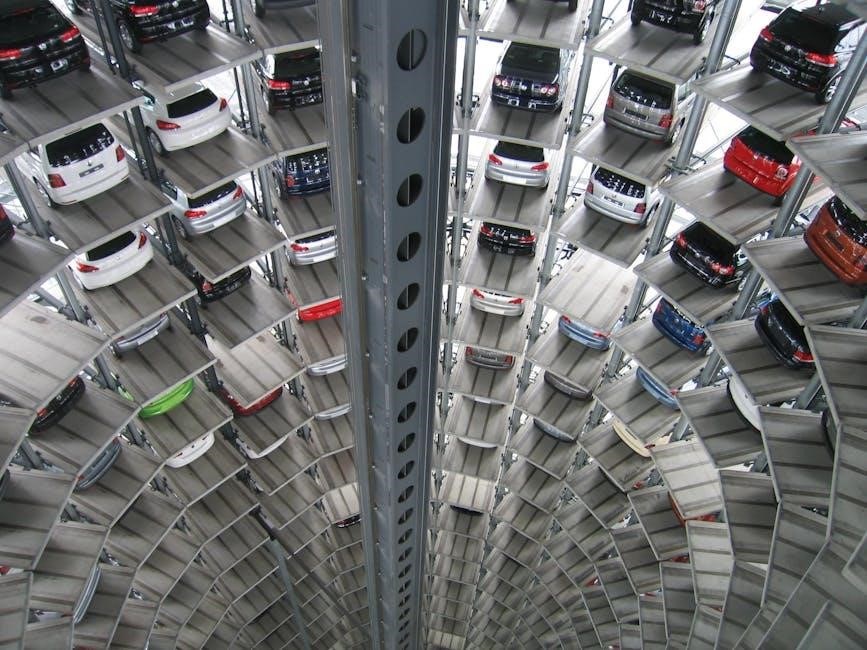rocket mass heater plans pdf
The Rocket Mass Heater Plans PDF is a comprehensive guide offering detailed designs and instructions for building efficient, sustainable heating systems. It provides insights into the benefits of rocket mass heaters, including fuel efficiency and eco-friendly performance, making it a valuable resource for eco-conscious builders and homeowners seeking cost-effective solutions.
Overview of Rocket Mass Heaters
Rocket mass heaters are innovative, eco-friendly heating systems that burn small-diameter wood fuel in a high-temperature combustion chamber. They store heat in a thermal battery, often an earthen structure, providing long-lasting warmth. These systems are highly efficient, using 70-90% less fuel than traditional wood stoves. The design ensures clean combustion, reducing emissions and environmental impact. Ideal for sustainable living, rocket mass heaters offer a cost-effective, low-maintenance alternative to conventional heating systems, making them popular among environmentally conscious builders and homeowners.
Importance of Efficient Wood-Burning Heating Systems
Efficient wood-burning heating systems like rocket mass heaters are crucial for reducing environmental impact and energy costs. They minimize fuel consumption, lower emissions, and provide sustainable warmth. These systems help reduce reliance on fossil fuels, promoting eco-friendly living. Their high efficiency ensures less wood is burned, preserving natural resources. Additionally, they offer a reliable heat source during power outages, making them a practical choice for off-grid homes. Efficient systems also contribute to better air quality and climate change mitigation, aligning with global sustainability goals.
Why Choose a Rocket Mass Heater?
A rocket mass heater offers exceptional efficiency, using 70-90% less fuel than traditional systems. It provides clean, safe, and consistent warmth while minimizing environmental impact. The system’s innovative design captures and stores heat effectively, reducing energy costs. Its eco-friendly nature aligns with sustainable living goals. Additionally, it operates quietly and requires minimal maintenance, making it a practical and reliable heating solution for homes, especially in off-grid or rural settings. This makes it a superior choice for those seeking a cost-effective, environmentally responsible heating option.

Understanding Rocket Mass Heater Design
Rocket mass heaters feature a high-efficiency combustion chamber and thermal battery for heat storage, enabling eco-friendly, sustainable heating with minimal fuel consumption and maximum warmth retention.
Key Components of a Rocket Mass Heater
A rocket mass heater consists of a high-efficiency combustion chamber, a thermal battery (like an earthen bench or floor), and an insulation layer. It also includes a heat exchange channel and a ventilation system for safe operation. The combustion chamber burns fuel at high temperatures, while the thermal battery stores and releases heat slowly. Proper insulation ensures minimal heat loss, and the ventilation system maintains airflow and safety. These components work together to create an eco-friendly, efficient heating solution for homes.
Thermal Battery and Heat Storage
The thermal battery is a central component of a rocket mass heater, designed to store and release heat over time. Typically made from materials like cob or brick, it absorbs heat from the combustion process and radiates it slowly into the space. This innovative feature allows for consistent warmth even after the fire has burned out, improving efficiency and reducing fuel consumption. The thermal battery is often integrated into a bench, floor, or wall, making it both functional and aesthetically appealing. Properly designed, it ensures long-lasting heat with minimal fuel use.
High-Temperature Combustion Chamber
The high-temperature combustion chamber is a critical feature of rocket mass heaters, enabling efficient fuel burning at elevated temperatures. Insulation surrounds the chamber to maintain heat, ensuring complete combustion of wood and minimizing emissions. This design promotes a clean, efficient burn, reducing pollutants and maximizing energy output. The chamber’s high heat output is transferred to the thermal battery, which stores and releases warmth over time. This innovative design ensures optimal performance, making rocket mass heaters both eco-friendly and cost-effective for home heating solutions.

Building a Rocket Mass Heater
A high-temperature combustion chamber is essential for efficient fuel burning in rocket mass heaters. Insulated to retain heat, it ensures complete wood combustion, reducing emissions and enhancing energy output. This chamber is crucial for achieving the optimal performance of the heater, making it eco-friendly and cost-effective for sustainable home heating solutions. Proper engineering and materials ensure safety and durability, maintaining high temperatures for effective heat transfer to the thermal battery. This design element is vital for maximizing efficiency and minimizing environmental impact.
Materials Needed for Construction
Building a rocket mass heater requires specific materials to ensure efficiency and durability. Key components include firebrick or ceramic insulation for the combustion chamber, steel for the stovepipe, and natural materials like cob or sand for the thermal battery. Gravel and insulation materials are used for the base and surrounding areas to enhance heat retention. Heat-resistant mortar is essential for sealing and constructing the heater’s core. Proper material selection ensures safety, optimal performance, and longevity of the system. These materials are widely available and cost-effective, making the project accessible for DIY enthusiasts and professional builders alike.
Step-by-Step Assembly Process
Constructing a rocket mass heater involves a systematic approach. Begin by preparing the site and leveling the floor. Next, assemble the combustion chamber using firebrick and heat-resistant mortar. Install the stovepipe and connect it to the thermal battery, ensuring proper insulation. Layer gravel and sand for the base, then add the earthen masonry around the core. Finally, finish with a protective layer and decorative touches. Each step requires precision to ensure safe and efficient operation. Detailed plans guide builders through this process, making it achievable for both professionals and DIY enthusiasts.
Integration with Existing Heating Systems
Rocket mass heaters can be seamlessly integrated with existing heating systems, enhancing overall efficiency. This includes connecting to ductwork, radiators, or hydronic systems. Proper installation ensures compatibility and safety. Homeowners can enjoy dual heating sources, reducing reliance on conventional systems. Professional guidance is recommended to optimize performance and ensure compatibility. This integration not only improves comfort but also lowers energy costs, making it a practical solution for modern homes. Detailed plans provide step-by-step guidance for successful integration, ensuring a cohesive and efficient heating setup.

Safety Considerations
Proper installation and ventilation are critical for safe operation. Ensure fire safety with regular maintenance and adherence to regulations. Protect your home and family with reliable performance.

Proper Installation and Ventilation
Proper installation is critical to ensure safe and efficient operation of a rocket mass heater. Correct ventilation design prevents carbon monoxide buildup and ensures complete combustion. A well-planned venting system maximizes heat exchange while maintaining airflow efficiency. Following installation guidelines is essential to avoid hazards and optimize performance. Regular inspections and maintenance of vents and connections are vital for sustained safety and functionality. Proper setup ensures reliable operation and minimizes risks, making it a cornerstone of rocket mass heater safety standards.

Fire Safety and Maintenance Tips
Fire safety is paramount when operating a rocket mass heater. Ensure the area around the heater is clear of flammable materials and install smoke detectors nearby. Regularly inspect and clean vents to prevent soot buildup. Maintain proper airflow to avoid incomplete combustion, which can produce harmful gases. Store fuel in a dry, well-ventilated space to prevent mold and moisture issues. Schedule annual professional inspections to ensure system integrity and safety. Always follow local fire safety guidelines and keep a fire extinguisher nearby. Proper maintenance ensures reliable and safe operation.
Regulations and Compliance
Before installing a rocket mass heater, ensure compliance with local building codes and emissions regulations. Many areas require permits and inspections for non-traditional heating systems. Check with local authorities to verify if your design meets fire safety standards. Some regions may restrict wood-burning devices during certain seasons due to air quality concerns. Proper documentation and adherence to regulations can avoid legal issues. Always consult with a certified professional to ensure your system meets all necessary requirements and standards for safe and legal operation.

Optimizing Performance

Maximize efficiency by ensuring proper airflow, using dry wood, and maintaining the combustion chamber. Regular cleaning and inspections optimize heat output and longevity of the heater.
Fuel Efficiency and Wood Usage
Rocket mass heaters are renowned for their exceptional fuel efficiency, often using 70-90% less wood compared to traditional systems. They work best with small-diameter, well-seasoned wood, ensuring complete combustion. The high-temperature combustion chamber and thermal battery design maximize heat extraction, reducing fuel needs. Properly sized wood and low moisture content are crucial for optimal performance. This eco-friendly approach minimizes wood consumption while providing sustained warmth, making it an ideal choice for environmentally conscious homeowners seeking to lower their heating costs and carbon footprint.
Maximizing Heat Output
Rocket mass heaters excel at maximizing heat output through their advanced design. The high-temperature combustion chamber ensures complete fuel combustion, releasing intense heat into the thermal battery. This stored heat is then gradually released, providing consistent warmth over extended periods. Proper installation, insulation, and airflow further enhance efficiency, ensuring minimal heat loss. By leveraging the system’s ability to store and release heat slowly, users can achieve optimal warmth with minimal fuel input, making it a highly effective heating solution for residential spaces.
Monitoring and Adjusting Performance
Monitoring and adjusting a rocket mass heater ensures optimal performance and efficiency. Regularly check temperature levels, airflow, and fuel quality to maintain high combustion efficiency. Adjustments may include tweaking the fuel load, insulation, or airflow paths to maximize heat output. Proper maintenance, such as cleaning the combustion chamber and ensuring clear ventilation, is crucial for sustained efficiency. By closely monitoring performance and making necessary adjustments, users can achieve consistent, reliable heat while minimizing fuel consumption and environmental impact.

Common Mistakes to Avoid
Common mistakes include improper installation, poor ventilation, and using incorrect materials. These errors can lead to reduced efficiency and safety hazards. Always follow guidelines carefully.
Design Flaws and Their Solutions
Common design flaws include insufficient insulation, improper combustion chamber sizing, and inadequate thermal mass connection. To address these, ensure precise design calculations, use fireproof materials, and maintain proper insulation. Additionally, incorrect duct installation can hinder performance, so follow expert guidelines for optimal airflow and heat distribution. Regularly inspect and adjust components to prevent efficiency losses and safety risks, ensuring long-term reliability and effectiveness of the rocket mass heater system.
Material Selection Pitfalls
Selecting the wrong materials can compromise efficiency and safety. Avoid using materials that cannot withstand high temperatures, such as low-quality bricks or insufficient insulation. Poor insulation materials can lead to heat loss and reduced performance. Additionally, using improper metals for ductwork can cause corrosion or leaks. To avoid these pitfalls, opt for firebrick, high-temperature ceramics, and durable insulation materials. Ensure all components are heat-resistant and properly sealed to maintain efficiency and longevity of the rocket mass heater system.
Operational Errors
Operational errors can significantly reduce the efficiency and safety of a rocket mass heater. Common mistakes include improper fuel loading, incorrect ignition techniques, and poor airflow management. Overloading the combustion chamber or using damp wood can lead to incomplete combustion and reduced heat output. Additionally, failing to monitor temperatures or neglecting regular cleaning can cause long-term damage. To avoid these errors, ensure proper fuel preparation, maintain optimal airflow, and regularly inspect the system for blockages or wear. Consistent maintenance and adherence to operational guidelines are crucial for optimal performance and safety.

Case Studies and Real-World Applications
Rocket mass heaters have been successfully installed in various homes and spaces, showcasing their efficiency and cost-effectiveness. Real-world applications highlight significant savings and reliable performance.
Successful Rocket Mass Heater Installations
Various installations worldwide demonstrate the effectiveness of rocket mass heaters. A notable case in a cold-climate home reduced fuel usage by 80% while maintaining consistent warmth. Another installation in a workshop highlighted durability and reliability over years of use. These examples underscore the system’s ability to provide sustainable, efficient heating solutions across diverse settings, proving its practicality and eco-friendly benefits for long-term use.
Lessons Learned from Builders
Builders highlight the importance of precise construction and proper installation to ensure optimal performance. Many emphasize the need for meticulous design planning to avoid common pitfalls. Experienced builders also stress the significance of regular maintenance and proper ventilation. Additionally, they recommend using high-quality materials to enhance durability and efficiency. These insights, gathered from real-world applications, provide valuable guidance for those aiming to construct a reliable and long-lasting rocket mass heater system.
Cost Savings and Efficiency Reports
Many builders and homeowners report significant cost savings after installing rocket mass heaters, with some noting reductions in fuel consumption by up to 90%. The system’s ability to store heat in thermal mass reduces the need for continuous fuel burning, lowering energy bills. Long-term savings are further enhanced by the durability of the materials and minimal maintenance requirements. These efficiency reports highlight the practical and financial benefits of adopting rocket mass heater technology for sustainable and economical heating solutions;
The Rocket Mass Heater offers a sustainable, efficient, and eco-friendly heating solution, perfect for modern homes seeking reliable warmth with minimal environmental impact.
Rocket mass heaters offer exceptional efficiency, reducing fuel consumption by 70-90% compared to traditional systems. They provide clean, safe, and reliable heat while minimizing environmental impact. By storing heat in thermal mass, they deliver warmth long after the fire burns out. These systems are cost-effective, sustainable, and ideal for eco-conscious homeowners. Their compact design and minimal material requirements make them a practical choice for various spaces, ensuring consistent comfort with minimal effort and resource use.
Final Thoughts on Rocket Mass Heater Plans
Rocket mass heater plans offer a practical and sustainable solution for home heating, empowering builders to create efficient systems with minimal environmental impact. These designs emphasize resourcefulness and eco-friendly performance, making them a valuable choice for those seeking cost-effective and reliable warmth. By leveraging thermal mass and high-efficiency combustion, rocket mass heaters provide long-term benefits for both homeowners and the planet. This approach not only reduces fuel consumption but also fosters a community-driven movement toward sustainable living and energy independence.
